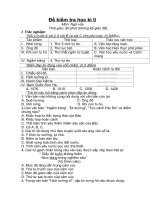kiemnghiemthucpham com 78297 AN231 IC melamine 20jul2009 LPN2279
Bạn đang xem bản rút gọn của tài liệu. Xem và tải ngay bản đầy đủ của tài liệu tại đây (616.58 KB, 7 trang )
Application Note 231
Determination of Melamine in Milk by
Ion Chromatography with UV Detection
INTRODUCTION
In 2008, melamine was found as a contaminant of
milk and milk-containing products after the discovery
of melamine contamination of pet food. These
contaminations resulted in infant and pet deaths. Both
deliberate contaminations originated in China, with
some contaminated products exported to neighboring
and more distant countries. Melamine was added to both
products to increase their apparent protein content, as it
was determined by a nonspecific total nitrogen test and
melamine has a large amount of nitrogen per unit mass.
Dionex has designed two reversed-phase HPLC
methods to determine the melamine adulteration of liquid
and powdered milk.1, 2 One method is an ion-pairing
HPLC method using an Acclaim®120 C18 column
and the other method uses the Acclaim Mixed-Mode
WCX column, where both the hydrophobic and cationic
properties of melamine are used to affect the separation.
As a cation, melamine can be separated by cationexchange chromatography and therefore be determined
by Ion Chromatography (IC). This Application Note
(AN) shows how melamine can be determined in milk,
powdered milk, and a milk-containing candy by IC using
an IonPac® CS17 column and UV detection at 240 nm.
This gives the analyst another chromatographic option,
providing a selectivity that may be needed for some
samples, or a way to increase sample throughput with
existing laboratory instrumentation.
EQUIPMENT
Dionex ICS-3000 consisting of:
DP Dual Pump
DC Detector/Chromatography module with dual
temperature zone equipped with
6-port valve (injection valve)
AM Automation Manager equipped with,
10-port valve (high pressure valve)
EG Eluent Generator
AS Autosampler
PDA-3000 Photodiode Array Detector*
Chromeleon® 6.8 Chromatography Data System
* The Dionex VWD detector can also be used for this
application. The photodiode array detector is required
to confirm the melamine peak identity with the peak
purity option.
Conditions
Column:
IonPac CS17 Analytical,
4 × 250 mm (P/N 060557)
Guard:
IonPac CG17 Guard,
4 × 50 mm (P/N 060560)
Concentrator:
IonPac TCC-LP1,
4 × 35 mm (P/N 046027)
Eluent Source: EGC II MSA (P/N 058902)
with CR-CTC (P/N 066262)
Gradient:
Flow Rate:
See chromatogram
Pump 1:1.0 mL/min
Pump 2:1.0 mL/min
Inj. Volume:
See chromatogram
Pressure:
~2100 psi
Detection:
UV at 240 nm
REAGENT AND STANDARDS
Deionized water (DI), Type I reagent grade, 18 MΩ-cm
resistivity or better
Melamine (Sigma-Aldrich)
Acetic acid (Labscan)
1. Calibration standards
To prepare melamine standards at concentrations of
25, 50, 100, 200, 400, and 800 µg/L, add the appropriate
volumes of 1 mg/mL standard to separate 100 mL
volumetric flasks. For example, add 5.0 mL of 1 mg/L
standard for the 50 µg/L standard. Bring to volume
with deionized water. These six standards were used to
calibrate one of the IC methods presented here, and for
the second method, we prepared an additional 12.5 µg/L
standard and calibrated with seven standards.
2. MDL standard
Prepare a 25 µg/L melamine standard by adding
2.5 mL of 1 mg/L melamine standard to a 100 mL
volumetric flask and bring to volume with
deionized water.
SAMPLE PREPARATION
OnGuard RP Preparation
Flush the OnGuard RP cartridge with 5 mL of
methanol and then with 10 mL of deionized water at
about 4 mL/min.
Liquid Milk Preparation
PREPARATION OF SOLUTIONS AND REAGENTS
Eluent Solution
The eluent generator produces the eluent using the
EluGen EGC II MSA cartridge and deionized water
supplied by the pump, with the eluent concentration
controlled by the Chromeleon software. Backpressure
tubing must be added to achieve 2000–2500 psi
backpressure that will allow the EG degasser to function
properly. See the ICS-3000 Ion Chromatography System
Operator’s Manual, (P/N 065031-03) for instructions on
adding backpressure.3
Standard Solutions
Stock Standard Solutions (1000 mg/L)
To prepare the 1000 mg/L melamine standard,
dissolve 0.1 g of melamine in 100 mL of deionized water.
Secondary Standards
Prepare a 1 mg/L secondary standard from the stock
standard. From this secondary standard, prepare the
standard calibrations and MDL standards as follows.
2
1. Mix 10 mL of liquid milk and 8 mL of deionized
water.
2. Add 2 mL of 3% acetic acid and mix.
3. Pass the sample through a Whatman 2V filter.
4. Pass 5 mL of the filtered sample through a prepared
OnGuard RP cartridge, discarding the first 3 mL and
collecting the remaining sample into an AS vial.
Milk Powder and Candy Sample Preparation
Add about 5 g of sample to a 50 mL volumetric flask,
dissolve, and bring to volume with deionized water. Take
10 mL of this sample and prepare by the same method as
the liquid milk sample.
Samples Spiked with Melamine
To prepare a 50 µg/L melamine spiked sample, in
step 1 of the sample preparation instead of adding 8 mL
of deionized water to the sample, add 1 mL of 1 mg/L
melamine secondary standard and 7 mL of deionized
water. For the 100 µg/L standard, use 2 mL of 1 mg/L
melamine and 6 mL deionized water.
Determination of Melamine in Milk by Ion Chromatography (IC) with UV Detection
Calculating Amount of Melamine in the Milk-Containing
Candy Sample
Pump-2, DI water
The sample preparation involved dissolving 5.079 g
of candy in 50 mL DI water and diluted 1:1.
Amount of candy in the 100 µL injection:
5.079g/50 mL × ((mL/1000 µL)/2) × 100 µL
= 5.079 × 10–3 g
Amount of melamine per g of candy:
= 13.78 × 10–4 µg/5.079 × 10–3 g
= 0.27 µg/g
Results and Discussion
Melamine is a cation and, therefore, can be
separated from other compounds by cation-exchange
chromatography. The IonPac CS17 column was designed
for the separation of hydrophobic amines like melamine.
While melamine is a cation at neutral pH, it is not fully
ionized at pH 7 and therefore, suppressed conductivity
does not provide a sensitive detection method for this
compound. Sensitivity can be increased using the salt
converter cation self-regenerating suppressor. However,
more sensitivity and selectivity for melamine was found
by using absorbance detection at 240 nm.
Milk and milk-based products can be difficult for
chromatographic methods due to the large variety of
compounds present that can interfere with the analytes
of interest. To determine melamine, we used a sample
preparation technique first developed for the IC
determination of iodide in milk.4 Despite this sample
preparation, we found it difficult to determine melamine
in the sample. Therefore, we first loaded the sample loop
installed on the AM-HP1 with the prepared sample. Then,
using deionized water, we moved the sample onto the
cation-exchange concentrator installed on the injection
valve, and then eluted from the concentrator, directly
onto the IonPac CS17 column set. Figure 1 shows the
schematic of this system configuration and Table 1
shows the valve programming that allows the sample
delivery to the concentrator while washing unbound
compounds to waste, and subsequent chromatography.
This method ultimately proved more successful for
melamine determination.
8
7
5
Waste
6
Sample out
4
AS Autosampler
Sample in
4
CG17
23
CS17
UV
2
1
Waste
3
5
6
TCC
-LP
1
= (13.78 µg/L) × (L/1,000,000 µL) × 100 µL
= 13.78 × 10–4 µg
2
Sample loop
9
Amount of melamine in 100 µL of the prepared
candy sample:
1
10
CR-CTC
Pump-1, EGC-MSA
26122
Figure 1. System configuration schematic.
Table 1. Valve Switching Program
Retention
Time (min)
AM_HP1
Injection
Note
Valve
–5.0
A
Load
–3.0
B
Load
0.0
A
Inject
End run
A
Inject
AS loads the sample to sample
loop before the AM_HP1
switches from A to B.
The end of runtime depends on
the gradient.
Prior to quantitative sample analysis, we calibrated
the method as described in the section Secondary
Standards, earlier in this application note. Figure 2 shows
the chromatography from the calibration, which was
linear with a correlation coefficient of 0.9998. To estimate
the minimum detection limit, we made seven injections
of the 25 µg/L standard. Figure 3 shows the seven
injections along with the blank, an injection of water.
The blank shows that there are no peaks from the water
or chromatography system interfering with melamine
determination. Table 2 shows the data from the MDL
experiment and that the MDL estimate was 4.4 µg/L.
Application Note 231
3
Columns:
IonPac CS17 Analytical, 4 × 250 mm
IonPac CG17 Guard, 4 × 50 mm
Concentrator: IonPac TCC-LP1, 4 × 35 mm
Eluent Source: EGC II MSA
Eluent:
Methanesulfonic acid (MSA):
10 to 30 mM from 0 to 10 min
Temperature: 30 °C
Flow Rate:
1.0 mL/min
Inj. Volume: 10 µL
Detection:
UV at 240 nm
Sample:
Standard calibration
IonPac CS17 Analytical, 4 × 250 mm
IonPac CG17 Guard, 4 × 50 mm
Concentrator: IonPac TCC-LP1, 4 × 35 mm
Eluent Source: EGC II MSA
Eluent:
Methanesulfonic acid (MSA):
10 to 30 mM from 0 to 10 min
Temperature: 30 °C
Flow Rate:
1.0 mL/min
Inj. Volume: 10 µL
Detection:
UV at 240 nm
Samples:
Blank and MDL standard
Columns:
8
Peaks:
3.00
Peaks:
Melamine 25, 50, 100, 200, 400 and 800 µg/L
Melamine
Melamine
25 µg/L
Melamine
mAU
mAU
–2
0
2
4
Minutes
6
8
10
26123
Figure 2 Chromatograms of six melamine standards used
for calibration.
After method qualification, we evaluated the
melamine content of milk, milk powder, and a milkcontaining candy. Only the candy was known to contain
melamine. Figures 4 and 5 together with Tables 3 and 4
show the results of the determinations of melamine in
milk and milk powder. The analysis shows that neither
sample contained melamine.
To demonstrate that melamine was not lost during
sample preparation, melamine was added to each sample
prior to sample preparation. One portion of each sample
was spiked with 50 µg/L melamine and a second portion
was spiked with 100 µg/L melamine. The chromatography
in Figures 4 and 5 and the quantitative results in
Tables 3 and 4 show that melamine was recovered from
both samples with recoveries greater than 90%.
4
–0.20
0
2
4
Minutes
6
8
10
26124
Figure 3. Chromatograms of a water injection (blank) and
seven consecutive injections of 25 µg/L melamine.
Table 2. Data from Seven Consecutive Injections
of 25 µg/L Melamine
Injection No.
Height (mAU)
1
0.0906
2
0.1071
3
0.0959
4
0.0924
5
0.0948
6
0.0969
7
0.0999
Average:
0.0968
RSD:
5.63
MDL (µg/L):
4.4
Determination of Melamine in Milk by Ion Chromatography (IC) with UV Detection
Columns:
IonPac CS17 Analytical, 4 × 250 mm
IonPac CG17 Guard, 4 × 50 mm
Concentrator: IonPac TCC-LP1, 4 × 35 mm
Eluent Source: EGC II MSA
Eluent:
Methanesulfonic acid (MSA):
10 to 30 mM from 0 to 10 min
Temperature: 30 °C
Flow Rate:
1.0 mL/min
Inj. Volume: 10 µL
Detection:
UV at 240 nm
Sample:
1. Milk
2. Milk + 50 µg/L melamine
3. Milk + 100 µg/L melamine
Peaks:
8
Melamine
1.
2.
3.
IonPac CS17 Analytical, 4 × 250 mm
IonPac CG17 Guard, 4 × 50 mm
Concentrator: IonPac TCC-LP1, 4 × 35 mm
Eluent Source: EGC II MSA
Eluent:
Methanesulfonic acid (MSA):
10 to 30 mM from 0 to 10 min
Temperature: 30 °C
Flow Rate:
1.0 mL/min
Inj. Volume:
10 µL
Detection:
UV at 240 nm
Samples:
1. Milk powder
2. Milk powder + 50 µg/L melamine
3. Milk powder + 100 µg/L melamine
µg/L
—
50.88
102.38
mAU
Peaks:
8
Melamine
1.
2.
3.
µg/L
—
49.03
90.45
Melamine
mAU
Melamine
2
1
–2
Columns:
3
2
1
3
–2
0
2
4
Minutes
6
8
0
10
2
4
6
8
10
Minutes
26125
26126
Figure 4. Chromatograms of milk and milk spiked with melamine.
Milk (1); milk + 50 µg/L melamine (2) ; and milk + 100 µg/L
melamine (3).
Figure 5. Chromatograms of milk powder and milk powder spiked
with melamine. Milk (1); milk + 50 µg/L melamine (2);
and milk + 100 µg/L melamine (3).
Table 3. Recovery of Melamine in the Milk Sample
Table 4. Recovery of Melamine
in the Milk Powder Sample
Amount (µg/L)
Injection #
Liquid Milk
Liquid Milk +
50 µg/L
Melamine
1
ND
53.58
96.20
2
ND
53.12
110.31
3
ND
44.42
93.54
4
ND
52.00
100.33
5
ND
51.27
111.51
Average:
NA
50.88
102.38
RSD:
NA
7.32
7.98
% Recovery:
NA
101.8
Liquid Milk +
100 µg/L
Melamine
102.4
Amount (µg/L)
Injection #
Milk Powder
Milk Powder +
50 µg/L
Melamine
Milk Powder +
100 µg/L
Melamine
1
ND
49.56
92.30
2
ND
56.27
89.74
3
ND
45.07
88.04
4
ND
49.16
88.74
5
ND
45.07
93.44
Average:
NA
49.03
90.45
RSD:
NA
9.35
2.57
% Recovery:
NA
98.06
90.45
Application Note 231
5
The analysis of the melamine-containing candy
sample proved more difficult. Melamine was not
completely resolved from another peak. This was not
observed in the milk and milk powder samples. To
resolve these two peaks, we changed the mobile phase
composition from a 10 min 10–30 mM MSA gradient to
5 mM MSA for 20 min. Due to the use of a RFIC system,
this mobile phase change and other changes made to
arrive at the final method did not require the preparation
of new eluents. We simply used the Chromeleon
chromatography workstation to instruct the eluent
generator to prepare a new mobile phase.
Our initial chromatography of the candy sample also
suggested that there was only a small amount of
melamine in the sample. Therefore, when we calibrated
the system for the new separation method, we added
a lower concentration standard (12.5 µg/L) to the
calibration and increased the injection volume from
10 to 100 µL. The calibration was linear with a correlation
coefficient of 0.9997.
Figure 6 and Table 5 show the results of the analysis
of the candy sample for melamine. The candy sample
contained melamine with a concentration of about
14 µg/L in the prepared sample, or 0.27 µg/g in the candy.
To assess the accuracy of this determination, we prepared
two spiked candy samples with (a) a 10 µg/L spike, and
(b) a 20 µg/L spike. Melamine was recovered from both
samples suggesting that the method is accurate. After
installing the photodiode array detector on our system,
we also confirmed that the melamine peak in the candy
sample was a spectral match to the melamine standard.
This IC method accurately determined melamine in
milk, milk powder, and a milk-containing candy after a
simple sample preparation. As this method uses a RFIC
system, the analyst does not have to prepare eluents and
can easily change the mobile phase for samples where
unknown peaks coelute with melamine.
Columns:
IonPac CS17 Analytical, 4 × 250 mm
IonPac CG17 Guard, 4 × 50 mm
Concentrator: IonPac TCC-LP1, 4 × 35 mm
Eluent Source: EGC II MSA
Eluent:
5 mM Methanesulfonic acid (MSA)
Temperature: 30 °C
Flow Rate:
1.0 mL/min
Inj. Volume: 100 µL
Detection:
UV at 240 nm
Sample:
1. Blank
2. Candy
3. Candy + 10 mg/L melamine
4. Candy + 20 mg/L melamine
Peaks:
7
Melamine
1.
2.
3.
4.
mAU
Melamine
12
–2
4
3
0
5
10
Minutes
15
20
26126
Figure 6. Chromatograms of milk-containing candy and candy
spiked with melamine. Blank (1); candy (2); candy + 10 µg/L
melamine (3); and candy + 20 µg/L melamine (4).
Table 5. Recovery of Melamine in the Candy Sample
Amount (µg/L)
Injection #
Candy
Candy +
10 µg/L
Melamine
Candy +
20 µg/L
Melamine
1
14.27
23.16
28.86
2
15.31
25.46
31.47
3
12.70
21.96
31.23
4
12.49
21.59
32.56
5
14.10
22.05
32.32
Average:
13.78
22.84
31.29
RSD:
8.51
% Recovery:
6
µg/L
—
13.78
22.84
31.29
Determination of Melamine in Milk by Ion Chromatography (IC) with UV Detection
6.91
4.69
90.66
87.55
References
1. Rapid Determination of Melamine in Liquid Milk and
Milk Powder by HPLC on the Acclaim Mixed-Mode
WCX-1 Column with UV Detection. Application Note
221 (LPN 2181, March 2009), Dionex Corporation,
Sunnyvale, CA.
2. Determination of Melamine in Milk Powder
by Reversed-Phase HPLC with UV Detection.
Application Note 224 (LPN 2184, March 2009),
Dionex Corporation, Sunnyvale, CA.
3. ICS-3000 Ion Chromatography System Operator’s
Manual, Document No. 065031-03. Dionex
Corporation, Sunnyvale, CA
4. Determination of Iodide in Milk Products.
Application Note 37 (LPN 0702-03, October, 2004),
Dionex Corporation, Sunnyvale, CA.
Acclaim, IonPac, and Chromeleon are registered trademarks of Dionex Corporation.
Passion. Power. Productivity.
Dionex Corporation
North America
Europe
Asia Pacific
1228 Titan Way
P.O. Box 3603
Sunnyvale, CA
94088-3603
(408) 737-0700
U.S./Canada (847) 295-7500
Austria (43) 1 616 51 25 Benelux (31) 20 683 9768 (32) 3 353 4294
Denmark (45) 36 36 90 90 France (33) 1 39 30 01 10 Germany (49) 6126 991 0
Ireland (353) 1 644 0064 Italy (39) 02 51 62 1267 Sweden (46) 8 473 3380
Switzerland (41) 62 205 9966 United Kingdom (44) 1276 691722
Australia (61) 2 9420 5233 China (852) 2428 3282 India (91) 22 2764 2735
Japan (81) 6 6885 1213 Korea (82) 2 2653 2580 Singapore (65) 6289 1190
Taiwan (886) 2 8751 6655
South America
Brazil (55) 11 3731 5140
www.dionex.com
Application Note 231
LPN 2279 PDF 07/09
©2009 Dionex Corporation
7
![[VNMATH.COM]-8.1_Pp_toa_do_trong_kg](https://media.store123doc.com/images/document/13/rc/ww/medium_wwx1362496294.jpg)








